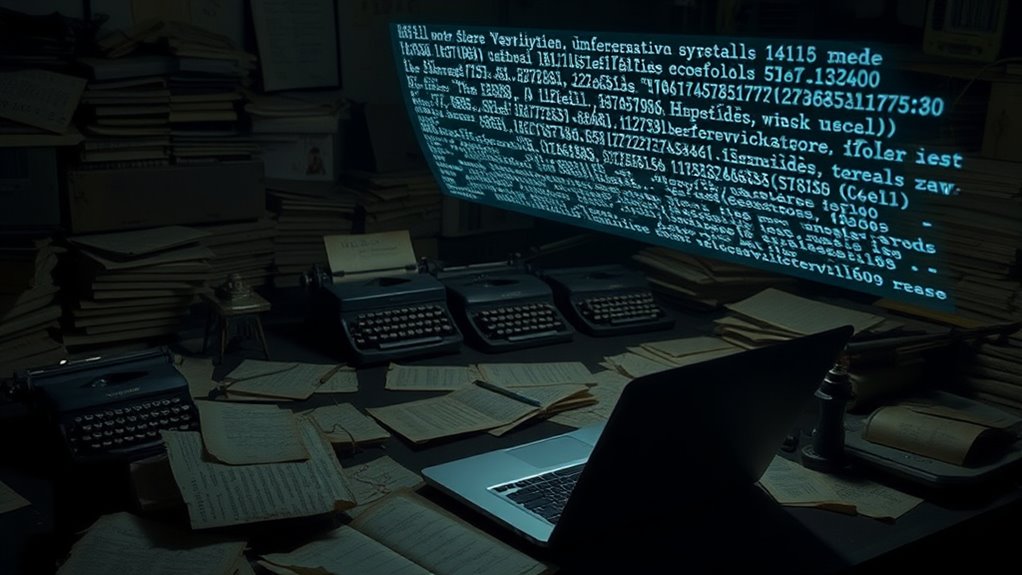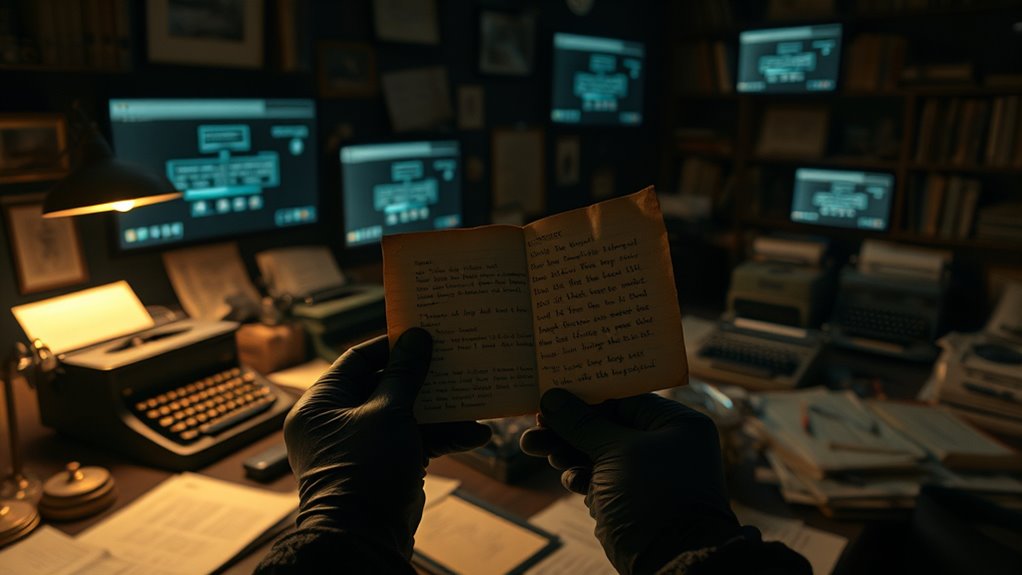The Venona Project, initiated in 1943, decrypted Soviet communications, exposing spies like Julius Rosenberg and Harry Dexter White. This intelligence not only shifted Cold War dynamics but also fueled the Red Scare in the U.S. Modern implications resonate today, emphasizing the need for strong counterintelligence and ethical surveillance practices as threats evolve. The challenges faced during Venona serve as a reminder of the balance between privacy rights and national security. Discover what else this project reveals about today's espionage landscape.
Key Takeaways
- The Venona Project successfully decrypted Soviet communications, revealing spies like Harry Dexter White and Theodore Hall in the U.S. government.
- Advanced cryptanalysis techniques from the Venona Project highlight the ongoing need for robust security against modern espionage threats.
- Ethical dilemmas surrounding data interpretation during the Venona Project inform current discussions on surveillance practices and privacy rights.
- The project's revelations influenced Cold War dynamics and public perception, emphasizing the importance of transparency in intelligence operations today.
- Lessons from the Venona Project, including inter-agency collaboration and innovation, remain relevant for addressing contemporary security challenges, including AI-related espionage.
The Origins of the Venona Project

When the U.S. initiated the Venona Project on February 1, 1943, it aimed to intercept and analyze Soviet diplomatic cables during World War II.
Led by Colonel Carter Clarke, the project focused on high-level communications that revealed extensive espionage activities infiltrating the United States government.
Utilizing signals intelligence, your code-breaking efforts would eventually decrypt about 3,000 messages, primarily between Moscow and U.S. stations.
Through signals intelligence, approximately 3,000 messages were decrypted, revealing crucial communications between Moscow and U.S. stations.
The project's success was partly due to a Soviet blunder involving the reuse of one-time pad materials, which allowed American cryptanalysts to crack previously secure codes.
This groundbreaking initiative remained shrouded in secrecy, even from top officials like Presidents Roosevelt and Truman, reflecting the operational confidentiality surrounding its critical findings.
Breakthroughs in Decryption Techniques

Although the Venona Project faced immense challenges, its breakthroughs in decryption techniques revolutionized intelligence gathering during the Cold War.
By leveraging advanced cryptanalysis, you saw American cryptanalysts successfully decrypt Soviet messages, mainly due to a significant blunder where Soviet operators reused key material. This mistake allowed you to identify patterns and vulnerabilities in encrypted communications, leading to the decryption of around 3,000 messages between 1943 and 1980.
These findings provided critical intelligence on Soviet espionage activities in the U.S. The early breakthroughs in the mid-1940s not only shed light on Soviet spies but also underscored the need for robust cryptographic security, paving the way for advancements in modern cybersecurity practices today.
Key Figures and Their Roles in Espionage

The world of espionage during the Cold War was shaped by several key figures whose actions had profound impacts on international relations.
The Venona Project revealed Soviet spies embedded within the U.S. government, including influential individuals like Harry Dexter White, who provided critical intelligence despite not being in the American Communist Party.
Theodore Hall, a physicist from the Manhattan Project, leaked sensitive atomic bomb information to Soviet operatives through his contact, Bernard Schuster.
Other notable figures included Alger Hiss and Julius Rosenberg, both implicated as assets within the espionage network.
Additionally, Soviet officials like Pavel Fitin and Anatoli Gromov orchestrated these operations, leveraging intelligence agencies to guarantee the success of their espionage efforts in America.
The Impact of Venona on Cold War Dynamics

As the Venona Project revealed the extent of Soviet espionage in the United States, it dramatically shifted the landscape of Cold War dynamics.
The decryption of over 3,000 Soviet messages exposed the infiltration of the U.S. government and key projects like the Manhattan Project, reshaping public perception and fueling the Red Scare.
The exposure of Soviet infiltration through decrypted messages reshaped public perception and intensified the Red Scare.
The impact can be summarized in three key ways:
- Heightened Suspicion: Venona's findings led to increased paranoia about communist infiltration in American institutions.
- Policy Shift: The U.S. government adopted more aggressive counterintelligence strategies to combat perceived threats.
- Historical Reevaluation: The project's eventual declassification prompted a reassessment of Cold War narratives and figures involved in espionage activities.
These revelations fundamentally influenced Cold War dynamics and American society.
Modern Implications of the Venona Discoveries

The Venona discoveries teach you valuable lessons about the importance of staying vigilant against espionage today.
As ideological subversion becomes more sophisticated, recognizing its signs is essential for protecting democratic institutions.
Lessons in Espionage Awareness
While many may view espionage as a relic of the Cold War, the lessons from the Venona Project remain essential for today's security landscape.
The extensive infiltration by Soviet spies highlighted the need for vigilance in national security. Here are three key takeaways for you:
- Strengthen Counterintelligence: Make certain intelligence agencies are equipped to detect and prevent foreign infiltration.
- Promote Transparency: Balance national security with public awareness to prevent ideological subversion that could compromise loyalty and patriotism.
- Educate Citizens: Foster ongoing education about the risks of espionage, empowering citizens to recognize and report suspicious activities.
2. Ideological Subversion Today
Understanding the lessons from the Venona Project reveals that ideological subversion remains a pressing concern in today's political landscape. The extensive Soviet espionage highlighted how foreign influence can exploit domestic beliefs to undermine national security.
Today, similar tactics are at play, as foreign entities infiltrate political systems using modern strategies reminiscent of Soviet agents. You need to recognize that the ideological fervor driving these actions can still lead individuals to act against national interests.
The Venona discoveries remind us of the importance of vigilance and robust counterintelligence efforts. By understanding these mechanisms of subversion, you can better identify and mitigate risks posed by state and non-state actors trying to manipulate public discourse and policy.
The Ethical Dilemmas of Surveillance and Data Interpretation

As you consider the ethical dilemmas of surveillance, think about the ongoing tug-of-war between privacy and national security.
The risks of data misinterpretation can lead to serious consequences, raising questions about how we define ethical surveillance practices.
It's essential to examine these issues to protect individual rights while ensuring safety in an increasingly monitored world.
Privacy vs. Security Balance
The ethical dilemmas surrounding privacy and security often emerge from the need to protect national interests while safeguarding individual rights. The Venona Project underscores this tension, highlighting several key concerns:
- Civil Liberties: Extensive surveillance can infringe on personal privacy, raising questions about the limits of government power.
- Intelligence Gathering: While decrypted messages aided in identifying Soviet spies, the secretive methods employed lack public oversight, risking abuse of power.
- Espionage Trials: The controversy around using intercepted communications as evidence reveals the ethical implications of transparency in legal processes.
As modern surveillance technologies evolve, you must consider how we balance the need for security with the protection of civil liberties.
This ongoing debate remains essential in shaping our understanding of privacy in a security-driven world.
Data Misinterpretation Risks
While data collection can provide critical insights for national security, it also poses significant risks of misinterpretation that can lead to serious ethical dilemmas.
The Venona decryptions illustrate how reliance on incomplete data can skew intelligence operations, raising ethical questions about the accuracy of surveillance findings. Misidentifying individuals, like Alger Hiss, highlights the dangers of drawing conclusions from ambiguous decrypted communications.
In addition, the use of intercepted data in political actions, such as the Rosenberg trial, complicates the ethical landscape, as context often remains obscured.
The historical impact of the Venona Project serves as a reminder that balancing national security interests with the ethical implications of data interpretation is a persistent challenge that continues to resonate today.
Ethical Surveillance Practices
Maneuvering the complex landscape of ethical surveillance practices requires balancing national security needs with individual privacy rights. The Venona Project's covert operations illustrate this delicate tension.
To navigate these challenges effectively, consider the following:
- Oversight and Accountability: Guarantee surveillance programs have robust oversight to prevent misuse and protect civil liberties.
- Informed Consent: Aim for transparency in data collection, giving individuals the opportunity to consent to surveillance practices.
- Bias in Data Interpretation: Implement ethical guidelines in data analysis to avoid prejudgment and guarantee fair treatment of individuals.
Lessons Learned for Contemporary Intelligence Practices

Understanding the lessons from the Venona Project can greatly enhance contemporary intelligence practices. The project's success hinged on secrecy, showing you must protect sensitive information in intelligence operations to thwart adversaries.
It also emphasized the importance of inter-agency collaboration; effective decryption efforts required coordinated actions among military and intelligence organizations.
Utilizing advanced cryptanalysis techniques, like identifying flaws in the one-time pad system, highlights the need for continuous innovation in security measures against evolving threats.
Furthermore, Venona's identification of key spies underscores the necessity of thorough vetting and continuous monitoring to mitigate insider threats.
Finally, the handling of Venona transcripts illustrates the importance of transparency and accountability, enriching historical understanding and guiding future intelligence practices.
Frequently Asked Questions
What Did the Venona Project Reveal?
The Venona Project revealed extensive Soviet espionage activities in the U.S. during and after WWII.
You'd discover that it decrypted around 3,000 messages, exposing key figures like Julius and Ethel Rosenberg and confirming their involvement in atomic espionage.
It also identified American officials as Soviet assets, highlighting the USSR's infiltration into significant U.S. projects, such as the Manhattan Project, fundamentally altering your understanding of Cold War espionage narratives.
Was the Venona Project Successful?
The Venona Project was like shining a flashlight into the dark corners of espionage. You'd see it successfully decrypted thousands of Soviet messages, uncovering a web of spies infiltrating the U.S. government.
While it provided essential insights into Soviet operations, it also faced limitations, as many identified spies escaped prosecution.
Ultimately, you'd recognize its impact on Cold War perceptions, but its legacy remains complex and somewhat unresolved in the domain of national security.
What Is the Venona Project in Simple Terms?
The Venona Project was a secret U.S. initiative that aimed to intercept and decode Soviet communications. It started in 1943 and focused on messages sent between the USSR and its operations in the U.S.
Over the years, you'd find that it decrypted about 3,000 messages, revealing vital information about Soviet espionage during World War II and the early Cold War.
This project helped uncover Soviet spies and their activities in America.
What Is the Venona Project Best Described As?
The Venona Project's best described as a top-secret U.S. government effort aimed at decrypting Soviet intelligence communications during and after World War II.
You'd find it focused on uncovering Soviet espionage activities within the United States, revealing how deeply they infiltrated critical projects like the Manhattan Project.
Over 37 years, it decrypted thousands of messages, providing invaluable insights into Cold War dynamics and the identities of key Soviet agents operating in America.
Conclusion
In unraveling the threads of the Venona Project, you've glimpsed the shadows of espionage that shaped history. The lessons learned echo through today's intelligence practices, reminding you that the dance of secrecy and surveillance still waltzes on. As you navigate the complexities of ethical dilemmas, keep in mind that understanding the past can illuminate the path forward. Just like the whispers of spies, the insights from Venona continue to resonate, urging caution and clarity in your modern pursuits.









